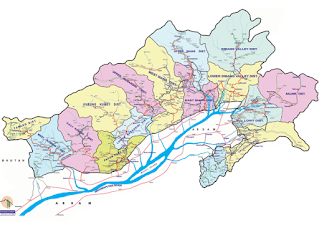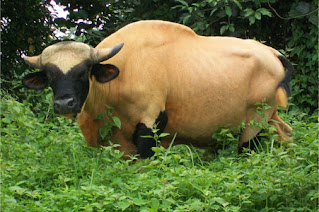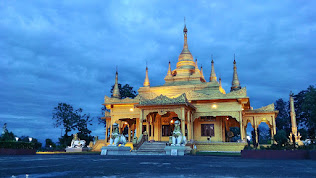Arunachal
Pradesh, state of India. It constitutes a mountainous area in the extreme northeastern
part of the country and is bordered by the kingdom of Bhutan to the west, the
Tibet Autonomous Region of China to the north, Myanmar (Burma) and the Indian
state of Nagaland to the south and southeast, and the Indian state of Assam to
the south and southwest. The capital is Itanagar.
Arunachal Pradesh is located between 26.28° N and 29.30° N latitude and 91.20° E and 97.30° E longitude and has an area of 83,743 km2 (32,333 sq mi)
Arunachal
Pradesh, meaning “Land of the Rising Sun,” long has been a recognized region of
the Indian subcontinent, receiving mention in such ancient Hindu literature as
the Kalika-purana and the epic poems Mahabharata and Ramayana.
Formerly known
as the North-East Frontier Agency (from the British colonial era), the area was
part of Assam until it was made the Indian union territory of Arunachal Pradesh
in 1972, and in 1987 it became an Indian state. The region, however, has been
the subject of an on-going sovereignty dispute between India and China.
 |
| Arunachal Pradesh Map |
A major
part of the state is claimed by the Republic of China, and the People's
Republic of China referring to it as "South Tibet". During the 1962
Sino-Indian war, Chinese forces temporarily crossed the McMahon line, the
border line between the state and China
 |
| Mithun |
Arunachal Pradesh is located between 26.28° N and 29.30° N latitude and 91.20° E and 97.30° E longitude and has an area of 83,743 km2 (32,333 sq mi)
The topography
rapidly rises to 7000 m at its highest peak. Kangte, Nyegi Kangsang, the main
Gorichen peak and the Eastern Gorichen peak are some of the highest peaks in
this region of the Himalayas. Numerous river valleys dissect the precipitous
terrain of Arunachal. Some of the major rivers are Kameng, Subansiri, Siang,
Dibang, Lohit and Noa-Dihing rivers.
Mountains until the Siang river are
classified under the Eastern Himalayas mountain range. Between the Siang river
and the Noa-Dihing river is classified as the Mishmi Hills that may be part of
the Hengduan Shan, but the true extents of these mountains is unclear. South of
the Noa-Dihing in Tirap and Longding districts, these mountains are parts of
the Patkai Range.
The rivers are fed by an immense abundance of forest cover that
absorbs moisture and transfers it to subsurface flows. Summer meltwater from
snowcaps also contribute to the volume of water. Either or both Dong Basti and
Vijaynagar basti in Arunachal Pradesh receives the first-morning sun rays in
the entire country, as the easternmost village of the country.
The mountain
ranges in Arunachal Pradesh are described as "the place where the sun
rises" in historical Indian texts and named the Aruna Mountains.
To study more about Arunachal Pradesh, some books recommendation given below. These are
also used as references for this article. So, I highly recommend you go through
these books. For details click the book title.

